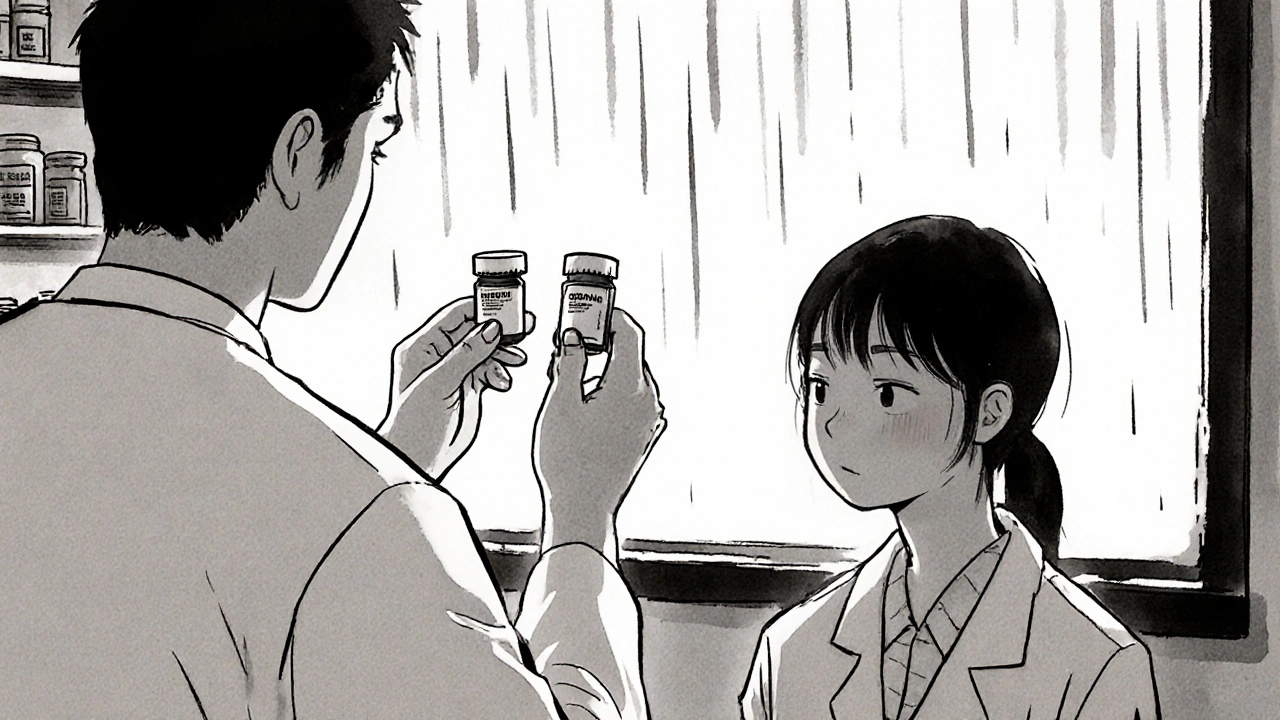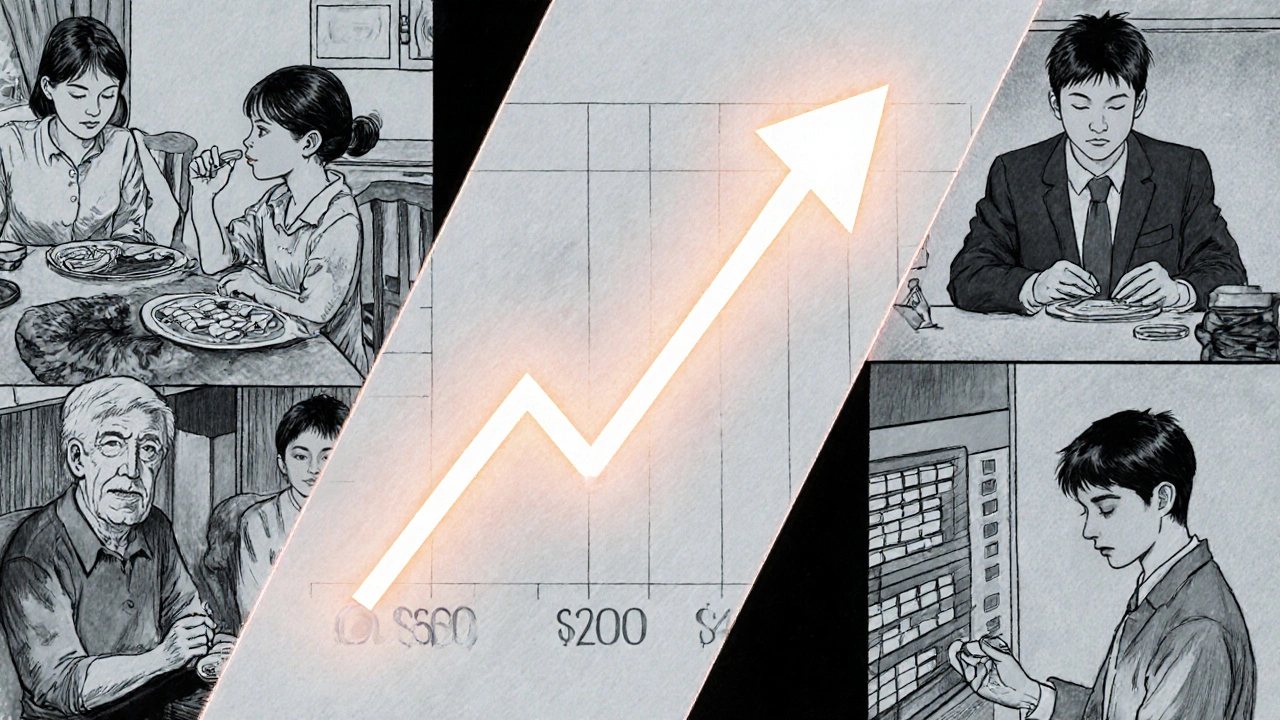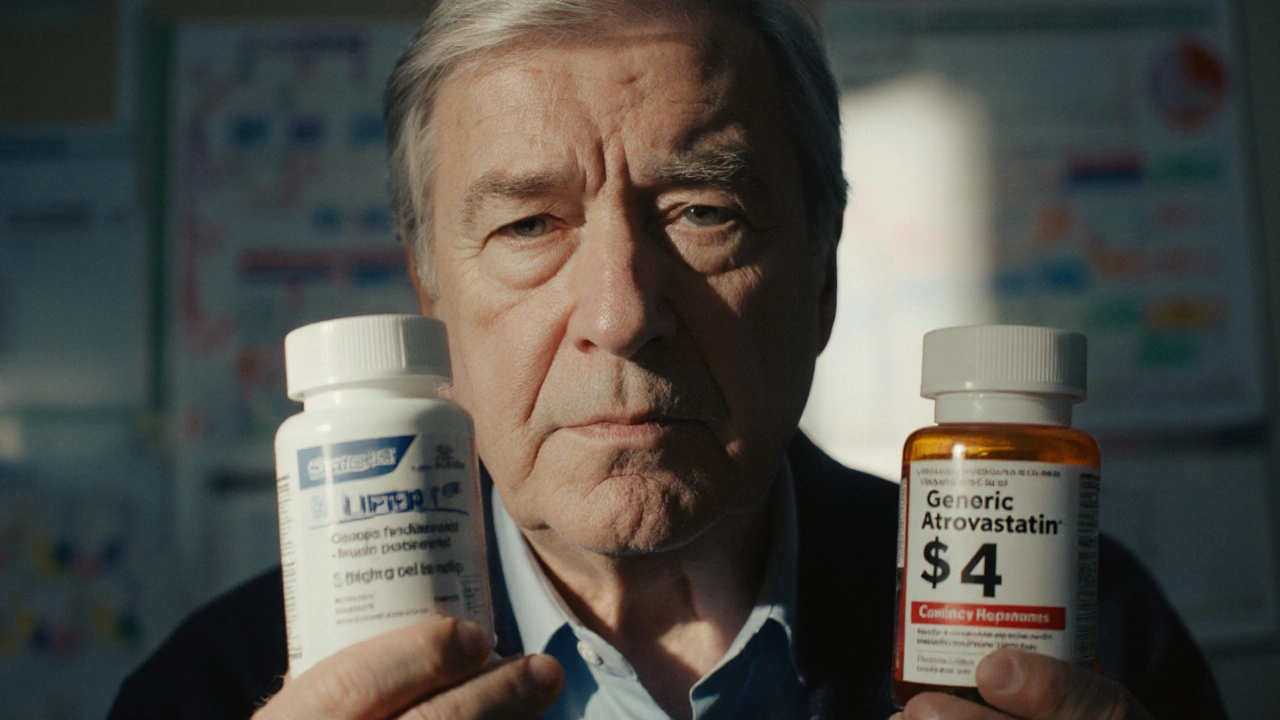Switching from brand-name medications to generics isn’t just a way to save money-it’s a smart, science-backed decision backed by decades of real-world use. If you’ve ever looked at your prescription bottle and wondered why the pill looks different, or heard a friend say, "I switched to generic and it works just as well," you’re not alone. The truth is, generic medications are not second-rate alternatives. They’re the exact same medicine, approved by the FDA, and used by millions every day-often at a fraction of the cost.
They’re the Same Drug, Just Cheaper
Generic medications contain the same active ingredients as their brand-name counterparts. That means if you take a generic version of atorvastatin, you’re getting the exact same chemical compound as Lipitor. The same goes for metformin instead of Glucophage, or fexofenadine instead of Allegra. The FDA requires that generics match the brand-name drug in strength, dosage form, route of administration, and how quickly the body absorbs it. This isn’t a guess-it’s proven through strict bioequivalence testing. For a generic to be approved, its absorption rate must fall within 80% to 125% of the brand-name drug’s levels in the bloodstream. That’s a tight range, designed to ensure there’s no meaningful difference in how the drug works.Cost Savings Are Real-And Massive
The biggest reason people switch? Price. Brand-name drugs carry the weight of years of research, marketing, and patent protection. Generics skip all that. Once a patent expires, multiple companies can make the same drug. Competition drives prices down. The FDA reports that generics cost, on average, 85% less than brand-name versions. In real terms, that’s not a small difference. Lipitor, a cholesterol-lowering drug, used to cost over $130 a month. Today, its generic version costs as little as $4. Warfarin, a blood thinner, runs about $4 for a 30-day supply as a generic, compared to over $300 for Coumadin. Metformin, used for type 2 diabetes, costs $4 a month as a generic, while Glucophage used to cost $300. That’s not a typo. That’s a $296 monthly savings.Insurance Plans Reward You for Choosing Generics
Most insurance plans, including Medicare Part D, have tiered pricing. Generics are almost always in the lowest tier. That means your copay might be $1 to $10 for a generic, versus $25 to $75 for a brand-name drug. Some plans even waive copays entirely for generics. Humana’s 2023 data shows that patients filling generic prescriptions pay an average of $1.85 per fill under Medicare Part D. For brand-name drugs, it’s over $33. That adds up fast-especially if you’re taking multiple medications. Even if you don’t have insurance, many pharmacies offer discount programs for generics. Walmart, CVS, and Costco all sell common generics for under $10 for a 30-day supply.They Work Just as Well-Here’s the Proof
A lot of people worry that generics might not work as well. But the science says otherwise. A 2022 study in the Journal of Managed Care & Specialty Pharmacy looked at over 186,000 patients taking generic versus brand-name heart medications. The results? No difference in effectiveness for treating high blood pressure or heart failure. Another study in the Journal of the American Heart Association confirmed the same findings. Even in high-stakes situations like epilepsy or thyroid disorders, the FDA maintains that approved generics meet the same standards. While some specialists note that for drugs with a narrow therapeutic index-where tiny changes in blood levels matter-careful monitoring is wise, there’s no evidence that generics are less effective when properly approved.
Patients Are Saving Billions-and Sticking to Their Meds
When medications are affordable, people take them. That’s a big deal. A 2023 study in Research in Social and Administrative Pharmacy found that patients using generics were 68% less likely to skip doses because of cost. That’s huge. Skipping pills because you can’t afford them leads to hospital visits, complications, and higher long-term costs. One patient on Reddit shared that switching their blood pressure meds to generic saved them $280 a month. Another wrote on PatientsLikeMe that metformin generics kept them on treatment when Glucophage was out of reach. These aren’t isolated stories. The Association for Accessible Medicines says generics saved the U.S. healthcare system $1.67 trillion between 2012 and 2022. That’s money that went back into people’s pockets, not drug company profits.What About the Different Color or Shape?
You might notice your generic pill looks different-smaller, rounder, a different color. That’s because inactive ingredients (like dyes, fillers, or binders) can vary. These don’t affect how the drug works. They just change the appearance. But that change can cause anxiety. Some patients worry the new pill isn’t the same. Pharmacists are trained to explain this. If you’re confused, ask. Most pharmacies will let you know if a manufacturer change happened. The FDA’s Orange Book lists all approved generics and their therapeutic equivalence ratings. If it’s rated AB, it’s interchangeable with the brand. No need to worry.Generics Are Heavily Regulated-More Than Ever
There’s a myth that generics are made in lower-quality factories. That’s outdated. The FDA inspects over 1,200 generic drug manufacturing sites every year-both in the U.S. and overseas. The Generic Drug User Fee Amendments (GDUFA), updated in 2022, require stricter oversight and faster reviews. Today, generics are held to the same quality standards as brand-name drugs. The FDA doesn’t treat them as second-class. In fact, many brand-name drugs are made in the same facilities as generics. The difference is in the branding, not the production.
When You Might Want to Be Cautious
There are rare cases where switching might need extra attention. For drugs with a narrow therapeutic index-like warfarin, lithium, or certain seizure medications-small changes in blood levels can matter. But even here, the FDA approves generics only if they meet strict bioequivalence standards. Most patients switch without issue. If you’re on one of these drugs and feel different after switching, talk to your doctor. But don’t assume the generic is the problem. Often, it’s stress from the change, not the drug itself.How to Make the Switch
Switching is simple. When your prescription is renewed, ask your doctor if a generic is available. Most doctors now prescribe generics by default. If your pharmacy switches your medication without telling you, check the label. If you’re unsure, ask the pharmacist. They can confirm it’s the same active ingredient and explain any changes in appearance. Most insurance plans automatically substitute generics unless the doctor writes "dispense as written" on the prescription. You don’t need to jump through hoops. Just ask.What’s Next? Biosimilars Are Coming
The next wave is biosimilars-generic versions of complex biologic drugs like Humira or Enbrel. These are harder to copy than traditional pills, but the FDA has approved 37 so far, with more on the way. They’re expected to save Medicare $50 billion annually by 2030. This trend shows the system is evolving to make even the most expensive treatments more affordable. Generics paved the way. Biosimilars are the next step.Are generic medications less effective than brand-name drugs?
No. Generic medications must meet the same FDA standards as brand-name drugs. They contain the same active ingredient, work the same way, and are absorbed into the body at the same rate. Studies involving hundreds of thousands of patients show no difference in effectiveness for conditions like high blood pressure, diabetes, or heart disease.
Why do generic pills look different?
Generic pills may differ in color, shape, or size because they use different inactive ingredients like dyes or fillers. These don’t affect how the drug works-only how it looks. The active ingredient, dosage, and effectiveness are identical. The FDA allows these differences to avoid trademark issues with brand-name packaging.
Can I trust generics made overseas?
Yes. The FDA inspects all manufacturing facilities-whether in the U.S., India, China, or elsewhere-to ensure they meet the same quality standards. Over 1,200 inspections are conducted each year. Many brand-name drugs are also made overseas. It’s not about where it’s made-it’s about whether it passes FDA inspections.
Will my insurance cover generics?
Almost always. Most insurance plans, including Medicare Part D, have lower copays for generics-often $1 to $10. Some plans even waive copays entirely. Brand-name drugs usually cost $25 to $75 or more. If your plan doesn’t cover a generic, ask your pharmacist to check for alternative generics or discount programs.
What if I feel different after switching to a generic?
It’s rare, but some people report feeling different-often due to anxiety about the change, not the drug itself. If you’re on a medication with a narrow therapeutic index (like warfarin or seizure drugs), contact your doctor. They can check your blood levels. For most medications, the generic is identical. Don’t stop taking it without talking to your provider.


Lemmy Coco
November 20, 2025 AT 06:22just switched my blood pressure med to generic last month and wow. my wallet is crying happy tears. used to pay $180 a month, now it’s $6. no idea why people still pay brand name prices unless they’re rich or just don’t care. also the pill looks different but i dont care if it works. 🤷♂️
rob lafata
November 21, 2025 AT 04:02oh please. generics are a scam cooked up by Big Pharma to keep you docile. the inactive ingredients? they’re laced with microchips to track your compliance. you think the FDA gives a shit? they’re paid off. i checked the label on my metformin-‘filler: cornstarch’-but cornstarch doesn’t dissolve that fast. something’s off. i’ve been taking my brand-name Glucophage for 12 years and i’m still alive. that’s not coincidence.
Matthew McCraney
November 23, 2025 AT 03:32you guys are all idiots. i’ve been on warfarin for 7 years. switched to generic once. woke up with a black eye and a nosebleed. turned out my INR was 6.8. the generic was ‘bioequivalent’ but my body knew. the brand was made in New Jersey. the generic? made in a basement in Bangalore. don’t be fooled by the FDA stamp. they’re just rubber-stamping Chinese factory rejects. i now pay $120 a month for Coumadin. it’s not about money. it’s about survival.
serge jane
November 23, 2025 AT 05:48there’s something deeply human about how we attach meaning to the shape and color of a pill. we’ve been conditioned to believe that if it looks different it must be different. but the science says otherwise. the body doesn’t care about branding. it only cares about molecular structure. the fact that we fear a blue pill over a white one says more about our relationship with medicine than any FDA report ever could. we’ve outsourced trust to corporations and now we’re terrified of anything that doesn’t come with a logo. maybe the real cost isn’t the pill-it’s the anxiety we pay for every month.
Nick Naylor
November 23, 2025 AT 18:23Brianna Groleau
November 24, 2025 AT 19:52i used to be terrified of switching. i thought my heart medication wouldn’t work the same. but then i talked to my pharmacist-she was so kind, showed me the orange book, explained everything in plain words. i switched to generic lisinopril and i’ve felt better than ever. no dizziness, no weird side effects. just… calm. i think it’s because i stopped stressing about it. the pill doesn’t care what color it is. your body just wants to heal. and honestly? the savings let me buy groceries for my mom. that’s the real win.
Rusty Thomas
November 25, 2025 AT 14:00okay but have you seen the generic versions of Adderall? they’re like little chalky rocks. i took one and felt like i was being slowly digested by a sloth. my brain was in molasses. i went back to brand. it’s not about money, it’s about quality. and if you think the FDA inspects every factory? lol. i read an article that said 80% of generic pills are made in India and China. do you know what kind of water they use there? i don’t even want to know. i’d rather pay $100 a month than risk my mental health on a pill that looks like it was made in a kindergarten art class.
Sarah Swiatek
November 26, 2025 AT 23:55you know what’s funny? the same people who panic about generic pills are the ones who’ll buy $12 organic kale from Whole Foods but won’t question the $200 bottle of vitamin D that’s made in the same factory as the $4 generic. we’re not scared of the pill-we’re scared of being fooled. and honestly? we’ve been fooled so many times by marketing, by ads, by doctors who get kickbacks, that we’ve learned to distrust everything-even science. the truth? the generic works. but the fear? that’s real. and it’s not about the medicine. it’s about the system that made us feel like we need to be afraid.
Dave Wooldridge
November 27, 2025 AT 16:44they’re watching us. every time you take a generic, they log it. your pharmacy, your insurance, your doctor-they’re all connected to the same database. they know when you switch. they know you’re saving money. and they don’t like it. next thing you know, your premiums go up. your copays double. they want you dependent. they want you paying $300 a month for a pill that costs 4 cents to make. don’t be fooled. this isn’t about healthcare. it’s about control.
Rebecca Cosenza
November 28, 2025 AT 16:07switched to generic metformin. no issues. saved $290/month. i’m not a hero. i’m just smart. 🤫
swatantra kumar
November 30, 2025 AT 01:37bro i live in india, generics are my bread and butter 😎. my dad takes 5 meds, all generics. cost? $2/month. here, brand names are for rich people and movie villains. i used to think same thing-"will it work?"-but after seeing my uncle’s diabetes stabilize on $1 generic insulin? i’m converted. FDA or not, if it works, it works. 🌏💊